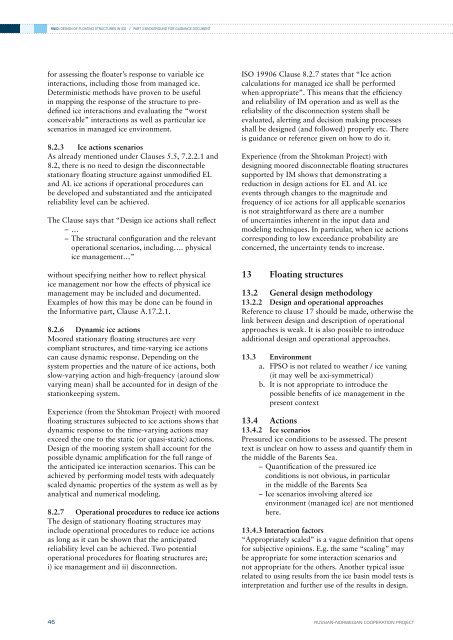phase 4 report - DNV
phase 4 report - DNV
phase 4 report - DNV
Create successful ePaper yourself
Turn your PDF publications into a flip-book with our unique Google optimized e-Paper software.
RN02: DESIGN OF FLOATING STRUCTURES IN ICE // PART 3 Background for Guidance Documentfor assessing the floater’s response to variable iceinteractions, including those from managed ice.Deterministic methods have proven to be usefulin mapping the response of the structure to predefinedice interactions and evaluating the “worstconceivable” interactions as well as particular icescenarios in managed ice environment.8.2.3 Ice actions scenariosAs already mentioned under Clauses 5.5, 7.2.2.1 and8.2, there is no need to design the disconnectablestationary floating structure against unmodified ELand AL ice actions if operational procedures canbe developed and substantiated and the anticipatedreliability level can be achieved.The Clause says that “Design ice actions shall reflect––…––The structural configuration and the relevantoperational scenarios, including…. physicalice management…”without specifying neither how to reflect physicalice management nor how the effects of physical icemanagement may be included and documented.Examples of how this may be done can be found inthe Informative part, Clause A.17.2.1.8.2.6 Dynamic ice actionsMoored stationary floating structures are verycompliant structures, and time-varying ice actionscan cause dynamic response. Depending on thesystem properties and the nature of ice actions, bothslow-varying action and high-frequency (around slowvarying mean) shall be accounted for in design of thestationkeeping system.Experience (from the Shtokman Project) with mooredfloating structures subjected to ice actions shows thatdynamic response to the time-varying actions mayexceed the one to the static (or quasi-static) actions.Design of the mooring system shall account for thepossible dynamic amplification for the full range ofthe anticipated ice interaction scenarios. This can beachieved by performing model tests with adequatelyscaled dynamic properties of the system as well as byanalytical and numerical modeling.8.2.7 Operational procedures to reduce ice actionsThe design of stationary floating structures mayinclude operational procedures to reduce ice actionsas long as it can be shown that the anticipatedreliability level can be achieved. Two potentialoperational procedures for floating structures are;i) ice management and ii) disconnection.ISO 19906 Clause 8.2.7 states that “Ice actioncalculations for managed ice shall be performedwhen appropriate”. This means that the efficiencyand reliability of IM operation and as well as thereliability of the disconnection system shall beevaluated, alerting and decision making processesshall be designed (and followed) properly etc. Thereis guidance or reference given on how to do it.Experience (from the Shtokman Project) withdesigning moored disconnectable floating structuressupported by IM shows that demonstrating areduction in design actions for EL and AL iceevents through changes to the magnitude andfrequency of ice actions for all applicable scenariosis not straightforward as there are a numberof uncertainties inherent in the input data andmodeling techniques. In particular, when ice actionscorresponding to low exceedance probability areconcerned, the uncertainty tends to increase.13 Floating structures13.2 General design methodology13.2.2 Design and operational approachesReference to clause 17 should be made, otherwise thelink between design and description of operationalapproaches is weak. It is also possible to introduceadditional design and operational approaches.13.3 Environmenta. FPSO is not related to weather / ice vaning(it may well be axi-symmetrical)b. It is not appropriate to introduce thepossible benefits of ice management in thepresent context13.4 Actions13.4.2 Ice scenariosPressured ice conditions to be assessed. The presenttext is unclear on how to assess and quantify them inthe middle of the Barents Sea.––Quantification of the pressured iceconditions is not obvious, in particularin the middle of the Barents Sea––Ice scenarios involving altered iceenvironment (managed ice) are not mentionedhere.13.4.3 Interaction factors“Appropriately scaled” is a vague definition that opensfor subjective opinions. E.g. the same “scaling” maybe appropriate for some interaction scenarios andnot appropriate for the others. Another typical issuerelated to using results from the ice basin model tests isinterpretation and further use of the results in design.46RUSSIAN–NORWEGIAN COOPERATION PROJECT






![Risk Based Pipeline Integrity Management [Compatibility Mode] - DNV](https://img.yumpu.com/50424229/1/190x146/risk-based-pipeline-integrity-management-compatibility-mode-dnv.jpg?quality=85)









